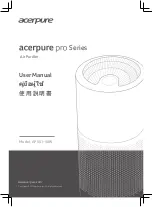
506253-01 Issue 0912
Page 3
Electrical Wiring
All field wiring must be done in accordance with the
National Electrical Code (NEC) recommendations,
Canadian Electrical Code (CEC) and CSA Standards, or
local codes, where applicable.
Refer to the furnace or blower coil Installation Instructions
for additional wiring application diagrams and refer to unit
rating plate for minimum circuit ampacity and maximum
overcurrent protection size.
1. Install line voltage power supply to unit from a properly
sized disconnect switch. Any excess high voltage field
wiring should be trimmed or secured away from the
low voltage field wiring.
2. Ground unit at unit disconnect switch or to an earth
ground. To facilitate conduit, a hole is in the bottom of
the control box. Connect conduit to the control box
using a proper conduit fitting. Units are approved for
use only with copper conductors. 24V Class II circuit
connections are made to the low voltage pigtails. A
complete unit wiring diagram is located inside the unit
control box cover (see also page 22 of this instruction).
3. Install room thermostat on an inside wall that is not
subject to drafts, direct sunshine, or other heat sources.
4. Install low voltage wiring from outdoor to indoor unit and
from thermostat to indoor unit (see Figure 3).
Unit must be grounded in accordance with
national and local codes. Failure to ground unit
properly can result in personal injury or death.
WARNING
5. Do not bundle any excess 24V control wire inside control
box. Run control wire through installed wire tie and tighten
wire tie to provide low voltage strain relief and to maintain
separation of field-installed low and high voltage circuits.
Refrigerant Piping
Figure 2
Slab Mounting
Discharge Air
Mounting Slab
Ground Level
Building
Structure
Thermostat Designations
Figure 3
See unit wiring diagram for power supply connections.
If the indoor unit is not equipped with a blower relay,
one must be field supplied and installed.
Do not connect C (common) connection between
indoor unit and thermostat except when required by
the indoor thermostat. Refer to thermostat installation
instructions. C (common) connection between indoor
unit and outdoor unit required for proper operation.
Power
Indoor Unit
Thermostat
Outdoor Unit
Heat
Cooling
Indoor Blower
R
W1
Y
G
C
R
W
Y
G
C
Y2
Y2
R
W
Y
G
C
Y2
If the 4SCU16LT unit is being installed with a new indoor
coil and line set, the refrigerant connections should be
made as outlined in this section. If an existing line set and/
or indoor coil will be used to complete the system, refer to
this section as well as the section that follows entitled
Flushing Existing Line Set and Indoor Coil
.
If this unit is being matched with an approved line set or
indoor coil which was previously charged with R22 refriger-
ant, the line set and coil must be flushed prior to installation.
If the unit is being used with an existing indoor coil which
was equipped with a liquid line which served as a metering
device (RFCI), the liquid line must be replaced prior to the
installation of the 4SCU16LT unit.
Field refrigerant piping consists of liquid and suction lines
from the outdoor unit (sweat connections) to the indoor
coil (flare or sweat connections).
Refrigerant can be harmful if inhaled. Refrigerant
must always be used and recovered responsibly.
Incorrect or irresponsible use of refrigerant can
result in personal injury or death.
WARNING




































